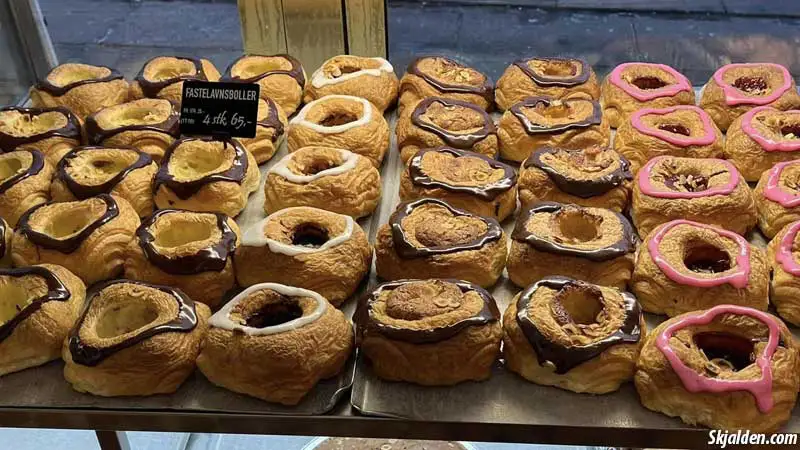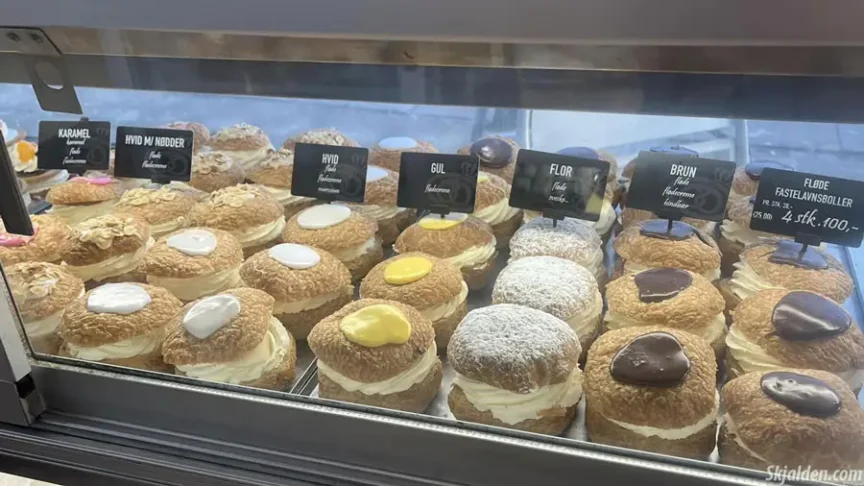Fastelavnsboller is a beloved pastry in Denmark and Norway, and it offers a unique twist on the Scandinavian tradition of sweet buns. While similar to Sweden’s Semlor, these pastries stand out with their regional variations and diverse flavors. Fastelavnsboller has its own unique charm and it is primarily enjoyed around the Fastelavn festivities, unlike Semlor which has a longer season.
Fastelavnsboller is synonymous with the pre-Lenten festival Fastelavn, celebrated in the Nordic countries. This seasonal pastry differs from the almond-paste-filled Semlor of Sweden, offering a range of fillings and flavors. Traditional Fastelavnsboller may feature whipped cream and almond paste, but variations include jam or custard, each adding a unique twist to this delicious pastry.
As mentioned, Fastelavnsboller is primarily enjoyed during Fastelavn, making it a special and anticipated treat. It’s often paired with coffee or tea, making a perfect balance of sweet, creamy, and aromatic flavors. This pastry is not just about taste; it’s part of the cultural fabric of Denmark and Norway, bringing families and communities together during the Fastelavn festivities.

Celebrating the Coronation of King Frederik X and Remembering Queen Margrethe
In 2024, Denmark marked a special year with King Frederik X’s coronation, and what better way to celebrate than with Fastelavnsboller? Sejers Konditori came up with their own version to honor the occasion. They made a Fastelavnsbolle, filled with whipped dark chocolate truffle and a tasty strawberry/rhubarb mousse, all topped off with a little crown on top.
And let’s not forget about our beloved former Queen Margrethe. They also made a Fastelavnsbolle for her too. This one’s got a delicious Cocio mousse mixed with blackcurrant jam, and topped with an elegant flower.

The Historical Origins of Fastelavnsboller: A Journey Through Time
The tradition of Fastelavnsboller dates back to the medieval period, intertwining with the history of Christian Europe. Fastelavn, stemming from the German word ‘Fastelabend’, or ‘the eve of the fast’, marks the beginning of the pre-Lenten celebrations. This period, notably the days leading up to Ash Wednesday, was a time for merrymaking and indulgence in anticipation of the 40-day Lenten fast.
In the context of Scandinavia, particularly Denmark and Norway, Fastelavn has been a notable celebration since at least the 14th century. The earliest versions of Fastelavnsboller during this time were likely quite plain, made from the basic ingredients available to a largely agricultural society. These early buns were more about sustenance than sweetness and likely bore little resemblance to the rich, flavorful pastries we see today.
The transformation of Fastelavnsboller into the sweet treat we know today started in the 17th and 18th centuries. This period saw the introduction of new culinary techniques and ingredients into Europe, including the widespread use of spices like cardamom and the increased availability of sugar. By the 19th century, with the advent of more refined baking methods and ingredients, Fastelavnsboller began to take on the characteristics of the modern pastry, filled with sweet almond paste and topped with whipped cream.
The evolution of Fastelavnsboller is also a reflection of the broader cultural shifts in Scandinavia. Initially, Fastelavn was predominantly a religious event, but over the centuries, it evolved into a more secular, family-focused celebration. This change is mirrored in the way Fastelavnsboller became not just a food item but a symbol of festivity, comfort, and family.
Final Thoughts
If you’re in Denmark or Norway around Fastelavn, then you’re in for a real treat with Fastelavnsboller. Each bakery you visit might have its own spin on this classic – some go for the creamy traditional almond paste and whipped cream, while others might surprise you with fillings like tangy raspberry jam or even a decadent chocolate custard. It’s the little things, like a sprinkle of cinnamon or a different kind of cream, that make each Fastelavnsboller unique. So, take the chance to try a few different kinds when you’re visiting; it’s a delicious way to get a taste of local flavors and traditions.
